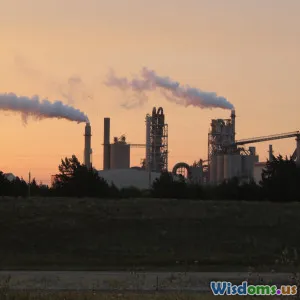
Riding a Bike to Work Real Environmental Benefits Unveiled
16 min read Unveil the profound environmental impacts of biking to work and discover how a simple commute can contribute to cleaner, greener cities and a healthier planet. (0 Reviews)
Riding a Bike to Work: Real Environmental Benefits Unveiled
Introduction
Imagine a morning commute where instead of idling in traffic, you feel the crisp air on your face, hear birds chattering, and see the world awakening around you. Biking to work isn't just about good vibes and personal health. Bowing beneath the surface of this growing trend lies an energy capable of reshaping urban landscapes, slashing pollution levels, conserving resources, and sparking a chain reaction of positive change. What exactly happens to the environment when you swap car keys for a bicycle helmet? Buckle up—or rather, clip in—as we reveal the real and often underestimated environmental benefits of riding a bike to work.
Cycling to Work: More Than a Commute
Biking isn't just an alternative; it’s a subversive answer to some of our most pressing environmental dilemmas. Across the globe, more people are embracing pedal power for daily transport. The League of American Bicyclists estimates that in the United States alone, over 870,000 Americans commute by bike as their primary means of transport to work (source: 2022 American Community Survey). That figure may sound modest—a small gear in the big machine of daily commutes—but the eco-impact accelerates quickly with every new rider.
Carbon Emissions: Cutting Down With Every Pedal
The Stark Truth About Motor Vehicle Emissions
Cars and trucks are leading contributors to greenhouse gas emissions across the world. According to the Environmental Protection Agency (EPA), transportation accounts for nearly 29% of total greenhouse gas emissions in the U.S., with the majority coming from personal vehicles. Each typical gas-powered car emits roughly 4.6 metric tons of carbon dioxide (CO₂) per year. Stepping away from the wheel, even just a few times a week, has a surprisingly large effect.
The Rider’s Advantage
Switching to a bike even for short commutes makes a significant dent. According to research published in the journal Transportation Research Part D: Transport and Environment, swapping the car for a bike just one trip per day reduces a person's carbon emissions from transport by 67%. Cycling a mere 5 miles to and from work four days a week eliminates around 2,000 pounds of CO₂ annually per rider. In cities where cycling-friendly infrastructure is more robust, the difference is even starker.
For example, Copenhagen—where approximately 44% of residents bike to work or school—has seen its collective vehicle-related emissions plummet. The Institute for Transportation and Development Policy estimates that if global cities could match Copenhagen's cycling practice, urban transport emissions could drop by 11% by 2050.
"Every trip you take by bike instead of by car is not just good for your health, it’s a small but measurable investment in our global climate goals.” — Dr. Celine Roche, Urban Mobility Researcher
Air Pollution and Urban Health
Cars vs. Clean Air
Automobiles emit not only carbon dioxide but also harmful pollutants—nitrogen oxides (NOx), fine particulate matter (PM2.5), and volatile organic compounds (VOCs)—that harm urban air quality and public health. The World Health Organization notes that air pollution contributes to an estimated 4.2 million premature deaths worldwide each year.
Direct Cleanliness: Bicycles Have Zero Exhaust
Bicycles emit no air pollution. When commuters shift to bikes, they drastically reduce their personal and collective contribution to city-smothering smog. A study from the University of Oxford asserted that if worldwide cycling rates doubled by replacing only 7% of car trips, it would reduce urban air pollution to levels associated with a 15% drop in mortality risks from respiratory and cardiovascular illness. London’s congestion charging and cycling incentives have already helped reduce NOx pollution in the inner city by up to 40% compared to 2000 levels.
Biking Infrastructure and Ripple Effects
Cities that expand bike lanes often see a multiplier effect. Cycling encouragement reduces car traffic, leading to reduced traffic congestion and, crucially, less engine idling—one of the sneakiest sources of urban air pollution. When New York City installed protected bike lanes along 8th and 9th Avenues in Manhattan, studies found not just drops in air pollution but also increases in neighborhood food and retail spending, creating healthier streets overall.
Waterways, Roadways, and Resource Conservation
Runoff and Water Quality
Vehicles not only clog roads but wash toxic pollutants—including oil, antifreeze, brake dust, and heavy metals—into storm drains, contaminating rivers and drinking water sources. The U.S. Geological Survey attributes a significant portion of urban water pollution to road runoff, primarily associated with high car volumes.
Cycling, by contrast, exerts a gentle footprint. One Dutch study found that increasing the share of bicycle commute trips to just 40% in cities could decrease urban runoff pollution by as much as 18%.
Infrastructure Impact
Cars are heavy and contribute to the degradation of city roadways, necessitating frequent, resource-heavy repairs. Bikes are light and far less destructive, meaning less energy, materials, and waste devoted to constant road and parking lot maintenance. In Portland, Oregon, the Bureau of Transportation found that while cars cause most road wear, their bike lanes and cycling paths remain in useable condition for far longer—some require significant maintenance only once a decade.
Land Use and Urban Sprawl
Beyond the road, every vehicle on the road demands parking spaces and storage. North American cities devote thousands of square miles to parking—space that could otherwise be green. According to the American Planning Association, there are up to eight parking spaces per vehicle in the U.S., a staggering allocation of land that contributes to the heat island effect and biodiversity loss.
Promoting biking—requiring mere square feet of bike racks instead of sprawling lots—allows for urban renewal, community green spaces, and repairs the delicate balance between concrete and nature.
Energy Efficiency: Powering Movement without Fossil Fuels
The Bicycle as a Paragon of Efficiency
Bicycles are the most energy-efficient mode of human transportation. A person on a standard bicycle expends about 35 kilocalories per mile, whereas a car consumes the energy equivalent of over 1,800 kilocalories per mile per occupant, according to research by David JC MacKay, physicist and sustainable energy author. Electro-assisted e-bikes—growing in popularity—still use a fraction of the energy even compared to public transit, and almost nothing compared to a private car.
Emissions Embedded in Manufacturing
Cars are resource- and energy-intensive to produce. The International Energy Agency (IEA) cites that manufacturing an average passenger vehicle emits between 5 to 10 tons of CO₂ (not counting fuel consumed throughout its lifetime). A bicycle, meanwhile, is estimated to emit 5% or less, typically less than half a ton, during manufacture. Given their long lifespan and relatively minimal maintenance requirements, bikes stand out as a model of sustainability from birth through use.
Urban Congestion: Freeing Up Our Cities
Time and Traffic: Why Fewer Cars Mean More Flow
Car-based commutes create massive time, resource, and environmental inefficiencies. According to the Texas A&M Transportation Institute Urban Mobility Report, the average urban commuter in the U.S. spent 54 additional hours sitting in traffic in 2022, wasting more than 3.6 billion gallons of fuel.
Bicycle commuting not only occupies less road space but also bypasses much of the congestion altogether. When major cities like Paris or Bogotá expand bikeways, traffic flow for all users noticeably improves; cycling frees up road and parking capacity so that buses and even remaining cars can move faster. Cities with cycling adoption programs in place, including the Netherlands and Denmark, routinely rank at the top of global indices for lowest urban congestion.
Social and Economic Upsides
Reducing congestion doesn't just fight emissions; it fosters active, accessible streets where human interaction and commerce flourish. A study in Toronto found streets with high cycling rates saw increased business revenue as more passers-by stopped at local shops. As travel times fall and local economies perk up, cities become more inviting, livable, and resilient.
Greenhouse Gas (GHG) Reductions in Global Perspective
Bicycling alone cannot single-handedly remedy global warming; however, its power compounds in urban environments, where half of humanity now resides. In Europe, the European Cyclists’ Federation calculated that if Europeans doubled their cycling trips to match the frequency of Dutch commuters, it would save 12 million tons of CO₂ annually—equal to the yearly emissions of small nations such as Latvia.
Towards a Post-Car Future
Ambitious planning reveals the potential. Paris’s Plan Vélo aims for a “100% cyclable city” by 2026, hoping to further slash the capital’s emissions while improving city life. Early results from expanded lanes and car-free days show CO₂ reductions, improved street health, and gradually changing public perceptions about what the modern city can look like.
Building a Bike Culture: Barriers, Solutions, and Real Impacts
The Infrastructure Investment Dilemma
One of the chief obstacles to cycling uptake is safety—a challenge met head-on in cycling-friendly cities like Utrecht, where physically separated lanes and traffic-calming policies protect riders. Investing in cycle tracks, bike-share programs, and secure parking pays dividends; the rise in ridership closely tracks infrastructural support in locales worldwide, from London’s “Cycle Superhighways” to Santiago’s rapid expansion of public bike systems.
Overcoming Misconceptions
Some may argue that cycling’s footprint is minimal compared to the promises of electric cars or mass transit. Yet, cycling erases emissions entirely during operation and requires far fewer technological or supply-chain breakthroughs. Rather than an “either-or” proposition, cities find greatest success when cycling, transit, and walking work in harmony, reducing dependence on all personal vehicles—electric or otherwise.
Case Study: Seattle’s Transformation
In 2014, only about 2.8% of Seattle’s workers cycled to work, according to city statistics. With the launch of interconnected greenways and support programs, that number more than doubled within seven years. Corresponding environmental monitoring credits bike commuting with year-on-year reductions in per-capita transportation emissions, while local air quality monitors recorded corresponding trends of cleaner air in central neighborhoods.
The Personal and Collective Impact
Every Ride Counts
While the social and policy landscape plays a pivotal role, individual commuters hold immense power to drive change. If the average American replaced just half of their weekly car trips under five miles with a bike, more than 60 billion pounds of CO₂ could be slashed from nationwide emissions each year (EPA estimate).
Psychological Benefits Fuel Behavior Change
Surveys and behavior studies repeatedly show that once people make the switch, they stay for both personal and planetary health—with more than half of new bike commuters in cities like Berlin, Minneapolis, and Taipei reporting that improved city air and green surroundings were chief motivators to keep biking. These shifts influence family, friends, and colleagues as “biking culture” becomes contagious.
Conclusion: Two Wheels, Infinite Possibilities
Riding a bike to work may seem like switching gears on a small scale. Yet each push on the pedals does more than move an individual: it catalyzes a transformation at street, city, and even global levels. From dramatic carbon reduction and improved urban air, to preserved roadways and renewed urban space, the humble bicycle emerges as one of the most potent tools in humanity’s toolkit against environmental decline.
So, next time you choose how to commute, imagine not just the ride itself but the cleaner world you leave in your wake. And consider this: in a world seeking effective solutions, sometimes the answer is as simple as two wheels and the courage to spin change.
Sources
- U.S. Environmental Protection Agency (EPA)
- League of American Bicyclists
- Institute for Transportation and Development Policy (ITDP)
- World Health Organization (WHO)
- University of Oxford
- European Cyclists’ Federation
- Texas A&M Transportation Institute
- American Planning Association
- Portland Bureau of Transportation
Rate the Post
User Reviews
Popular Posts




















